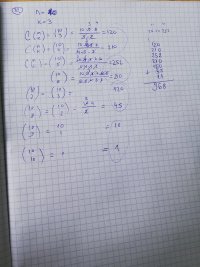You are using an out of date browser. It may not display this or other websites correctly.
You should upgrade or use an alternative browser.
You should upgrade or use an alternative browser.
Combinations
- Thread starter Loki123
- Start date
That's not correct. 968 is correctThere are [imath]2^{10}[/imath] different combinations altogether. Just take away (1+10+45).
BigBeachBanana
Senior Member
- Joined
- Nov 19, 2021
- Messages
- 2,182
Lex's correct, maybe you didn't subtract correctly.That's not correct. 968 is correct
[math]2^{10}-{10\choose 0}-{10\choose 1}-{10\choose2 }=1024-1-10-45=968[/math]
Oh yeah. But why that way? I don't understand it.Lex's correct, maybe you didn't subtract correctly.
[math]2^{10}-{10\choose 0}-{10\choose 1}-{10\choose2 }=1024-1-10-45=968[/math]
BigBeachBanana
Senior Member
- Joined
- Nov 19, 2021
- Messages
- 2,182
From the binomial theorem,Oh yeah. But why that way? I don't understand it.
[math](x+y)^n=\sum_{k=0}^{n}{n \choose k}x^ky^{n-k}[/math]Let [imath]x=1,y=1,n=10[/imath] so you have:
[math] (1+1)^{10}=2^{10}=\sum_{k=0}^{10}{10 \choose k}={10\choose 0}+{10\choose 1}+{10\choose 2}+\dots+{10\choose10}\\ \underbrace{2^{10}-{10\choose 0}-{10\choose 1}-{10\choose 2}}_{\text{Lex's method}}=\underbrace{{10\choose 3}+\dots+{10\choose 10}}_{\text{Your method}} [/math]
But why 1+1 if we need to use at least 3 flowersFrom the binomial theorem,
[math](x+y)^n=\sum_{k=0}^{n}{n \choose k}x^ky^{n-k}[/math]Let [imath]x=1,y=1,n=10[/imath] so you have:
[math] (1+1)^{10}=2^{10}=\sum_{k=0}^{10}{10 \choose k}={10\choose 0}+{10\choose 1}+{10\choose 2}+\dots+{10\choose10}\\ \underbrace{2^{10}-{10\choose 0}-{10\choose 1}-{10\choose 2}}_{\text{Lex's method}}=\underbrace{{10\choose 3}+\dots+{10\choose 10}}_{\text{Your method}} [/math]
The total number of combinations using any number of flowers is [imath]2^{10}[/imath].
(Since, for each of the 10 flowers, we can either include it or not, in the arrangement:
giving [imath](\underbrace{2 \times 2 \times 2 \times... \times 2}_{\text{10 times}})[/imath] possible outcomes.
As you say, we need to have at least 3 flowers, so we eliminate the unwanted combinations (with 0 flowers, 1 flower, or 2 flowers).
[imath]2^{10} -\binom{10}{0} - \binom{10}{1} - \binom{10}{2}[/imath]
(Since, for each of the 10 flowers, we can either include it or not, in the arrangement:
giving [imath](\underbrace{2 \times 2 \times 2 \times... \times 2}_{\text{10 times}})[/imath] possible outcomes.
As you say, we need to have at least 3 flowers, so we eliminate the unwanted combinations (with 0 flowers, 1 flower, or 2 flowers).
[imath]2^{10} -\binom{10}{0} - \binom{10}{1} - \binom{10}{2}[/imath]
pka
Elite Member
- Joined
- Jan 29, 2005
- Messages
- 11,971
Your work is correct [imath]\sum\limits_{k = 3}^{10} \dbinom{10}{k}=968 [/imath] SEE HEREThere are 10 different flowers. In how many ways can you make a flower arrangement if you have to use at least 3 flowers.
I calculated combinations from 3 flowers to 10. Is there a shorter way? View attachment 32242
Good work!
Steven G
Elite Member
- Joined
- Dec 30, 2014
- Messages
- 14,394
We let x=y=1 so (x+y)n=\(\displaystyle (x+y)^n=\sum_{k=0}^{n}{n \choose k}x^ky^{n-k}\) becomes \(\displaystyle 2^n=\sum_{k=0}^{n}{n \choose k}\)But why 1+1 if we need to use at least 3 flowers
The 1+1 has nothing to do with the number of flowers you are picking. It is just to get rid of \(\displaystyle x^ky^{n-k}\)
So then aren't we just doing combinations without repetition?We let x=y=1 so (x+y)n=\(\displaystyle (x+y)^n=\sum_{k=0}^{n}{n \choose k}x^ky^{n-k}\) becomes \(\displaystyle 2^n=\sum_{k=0}^{n}{n \choose k}\)
The 1+1 has nothing to do with the number of flowers you are picking. It is just to get rid of \(\displaystyle x^ky^{n-k}\)
BigBeachBanana
Senior Member
- Joined
- Nov 19, 2021
- Messages
- 2,182
Why do you think it's with repetition? You have 10 different flowers.So then aren't we just doing combinations without repetition?
i said without.Why do you think it's with repetition? You have 10 different flowers.
BigBeachBanana
Senior Member
- Joined
- Nov 19, 2021
- Messages
- 2,182
You answered your own question.i said without.

